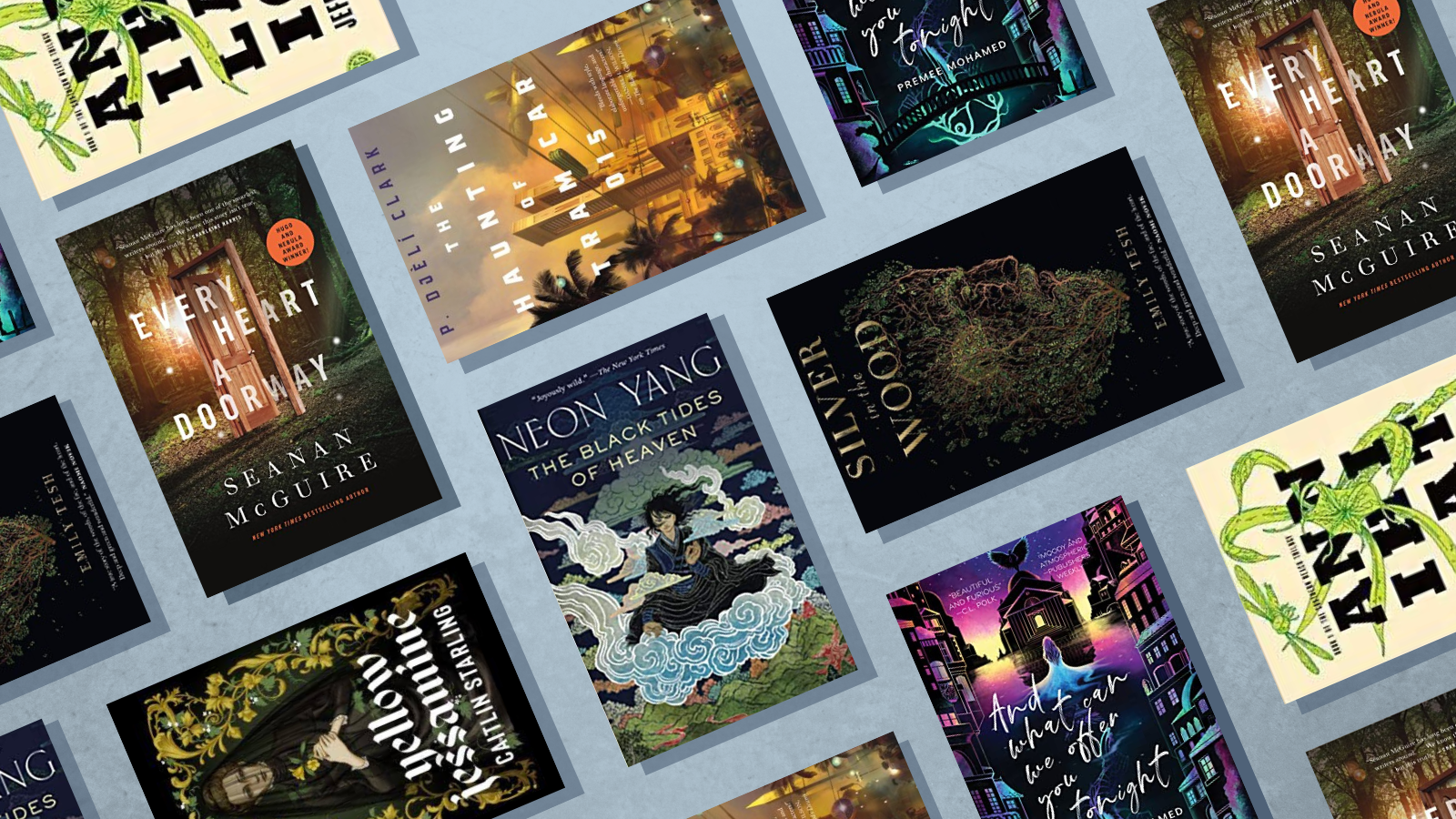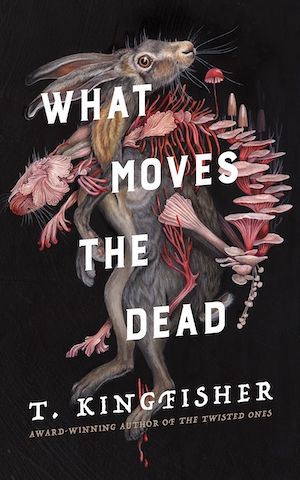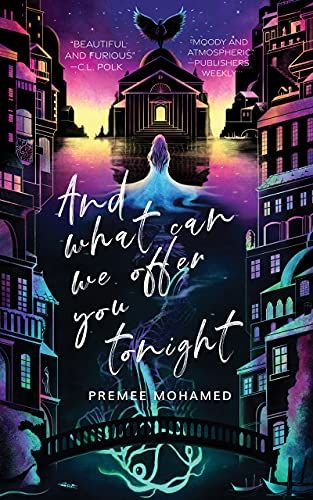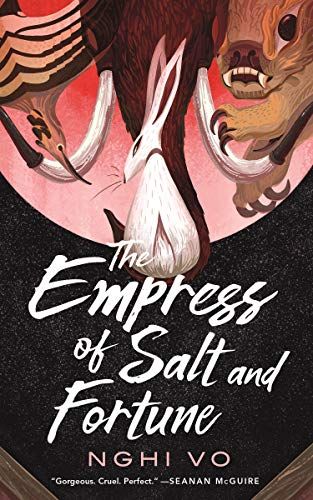The Rise of the Speculative Novella
On July 20th, Nebula award–winning author T. Kingfisher’s speculative novella What Moves The Dead made the USA TODAY bestseller list. At 176 pages, the novella follows Alex Easton, who races to Ruritania when they find out their childhood friend Madelyn Usher is dying. This super creepy (seriously, I am so suspicious of hares/bunnies/rabbits now) yet quick read is a magnificent retelling of Poe’s “The Fall of the House of Usher,” and — if USA TODAY is any indication — shows that readers appreciate when speculative novellas get it right.
TorDotCom Publishing and Hugo-nominated book editor Ruoxi Chen said creating worlds in the constraints of a novella is an incredible feat:
“Fantasy especially has a long history of using sheer bulk to establish atmosphere — and there’s a real pleasure in sinking into a book and world and settling in — but novellas force the writer to sharpen every aspect of the work, whether it’s showing thousands of years of history in a paragraph or setting up a philosophical quandary in a chapter.”
Novella vs. Novel
It is important to note that speculative novellas — and this includes SFF genre novellas — have a more solid distinction between novella and novel versus other genres, such as literary fiction. (I wrote about the definition(s) of speculative fiction in a previous article for Book Riot). Chen points to award word counts, such as the Hugo and Nebula award descriptions for novella and novel, as one reason why.
“A 40,000 word book in many other genres would simply be a novel, and we’re starting to see that blurriness bleed over more into SFF publishing,” Chen said. “Genre stalwarts marking Hugo ballots will be eyeing word counts, but there are also plenty of readers who will look at what they’re holding in their hands and simply think ‘book.’”
Additionally, when it comes to the reader, there is a mental shift of expectations when picking up a novella versus a novel, Tor senior editor Lindsey Hall said.
“Open endings feel more welcome, or stories where the character’s ‘arc’ doesn’t have to be as steep — perhaps we just go on a nice sort-of-slice of life journey with the character instead,” Hall said.
Tor and TorDotCom Publishing have been cornerstones of speculative novella publishing over the past few years, with both established writers publishing novella series — such as Seanan McGuire’s Wayward Children series — as well as authors debuting with a novella.
There was a time when, in order to read a speculative novella, one had to subscribe or purchase an issue of one of the notable genre magazines that publish them, such as The Magazine of Fantasy & Science Fiction and Asimov’s. Lately, however, publishers and magazines alike are making them more accessible to audiences. Novellas can be found online (like Uncanny Magazine novellas) and — with editors such as Hall and Chen taking the helm — conceptualized as books.
One-Session Reads
In addition to Tor and TorDotCom publishing novellas, small presses, too, have joined the speculative novella scene. Publisher and managing editor of Neon Hemlock, dave ring, said Neon Hemlock bounded into the novella space out of an enthusiasm for “‘one session reads’ that explore undertold themes from primarily queer voices.”
A one-session read is another great way to describe what a novella is. If we’re going off word count, like the Hugo and Nebula awards do, a novella is generally anywhere between 17,500 to around 40,000 words. Page count can vary as well, depending on the structure of the story. Neon Hemlock’s Nebula award-winning novella And What Can We Offer You Tonight by Premee Mohamed is about 80 pages (give or take, depending on the print or ebook edition) and about 21,000 words. T. Kingfisher’s What Moves the Dead is on the tail end of the spectrum, at a little over 40,000 words.
As previously mentioned, though, regardless of where they land in word count, novellas are powerful. They are bite-sized books that can hold the arc(s) and immensity of a novel. And readers are taking note.
A Speculative Novella Resurgence
With the appearance of presses like Neon Hemlock, and with staples of the genre like TorDotCom Publishing producing standalone novellas, it seems like this form is having a renaissance — or rather, a resurgence.
Resurgence might be the most accurate word, ring said:
“Typical novel length has fluctuated over the years, particularly in literary genres. So many classic adult novels of our youth are just beyond novella range. So it makes sense that we’re sometimes seeing that standard length boundary shift with novels that have a literary hybrid quality, like Karin Tidbeck’s Amatka or Jeff Vandermeer’s Annihilation. Ebooks certainly seem to have contributed a new appreciation for the novella, possibly by them appearing more commonly side by side with novels. Books that can be read in one sitting feel especially welcome during the pandemic as well; I know that’s true for myself at least.”
Hall agrees, noting in recent years especially that there isn’t a bad time, career-wise, for an author to publish a novella.
“I don’t want to speak incorrectly here but it’s my sense that, not too long ago, publishing a novella was seen as a side-step or a ‘something-else’ kind of move for an author,” Hall said. “Now, it seems pretty widely accepted that new authors can successfully build careers on novella-length works — like Neon Yang with The Black Tides of Heaven (which TIME called one of the Best Fantasy Books of All Time!), before then writing their debut novel, The Genesis of Misery (September 2022).”
What Makes a Good Speculative Novella
Your mileage may vary in preferences, of course, but I think we can agree a great speculative novella carries a lot weight on its small spine.
“A novella is a great opportunity to experiment with voice and structure, since it has less time to collapse under its own weight, allowing an author to try more ambitious forms,” ring said.
Because novellas are one-session reads, a reader may be more likely to roll with an unusual structure or voice. A reader may simply be willing to try a different genre or tale altogether. Novellas can also ride on a less climactic plot.
“I can enjoy an intensity of emotion in a novella that wouldn’t necessarily translate well to a novel — like in Veronica Roth’s upcoming Arch-Conspirator (February 2023),” Hall said. “It’s a reimagining of Antigone in an SFF setting, and it crushed me at every turn, in the very best ways. Roth weaves in hope and heartbreak on every page — there’s no word wasted — and I continue to think about the story even now, long after I read it for the first time.”
Going off of Hall’s previous point on debut authors, writing a novella might be more acceptable — and adaptable — if your novel in progress seems to be faltering. For you writers out there, take note:
“Another way to approach things could be looking at a novel outline and slicing out a subplot,” ring said. “How does the story look then? It might the right length for a novella.”
For emerging writers who do write novellas, there are also more avenues for submitting those works to publishers and literary magazines without requiring an agent.
“For any aspiring novella writers reading this, I want to leave you on this note: I am the lucky editor who published the most recent winner of the Hugo Award for Best Novella, Nghi Vo’s The Empress of Salt and Fortune,” Chen said. “She was a slush find who didn’t have an agent at the time, and — this fact still floors me — I was only the second person to read that extraordinary story. This is exactly how a novella would have been acquired in the early days of SFF, but the new reach of the format in the last decade or so has allowed a much larger readership to access Nghi’s and other novella writers’ work, and we are all the better for it.”
More Examples of Great Speculative Novellas
Below, I’ve included a few examples of some of my favorite novellas, describing what makes them successful using language and factors that Chen, Hall, and ring have described.
Relationships
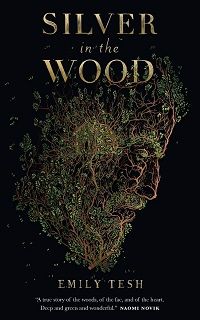
Silver in the Wood by Emily Tesh
Some of my favorite novellas really hone on in on a single relationship. Winner of the 2020 World Fantasy Award, Silver in the Wood follows two characters and their connection to each other. Tobias is bound to the quiet of Greenhollow wood, keeping watch over it with his cat and his dryads (one of these dryads is Bramble, who is honestly one of my favorite characters ever). Greenhollow Hall abuts the wood, and the new master of the hall, Henry Silver, is drawn to Tobias. The feeling is mutual, though complicated. The novella notes Tobias and Silver’s pasts and other relationships, but Tesh puts a magnifying glass on these two characters’ connection. A novel might require more. This novella is perfect as is.
Plot

The Haunting of Tram Car 015 by P. Djèlí Clark
Other novellas focus on a single, important plot, and then it can really pack the punch. This adventure novella is on the tail end of novella length, being about 35,000 words. It was a finalist for the 2020 Hugo, Nebula, and Locus awards and is part of Clark’s Dead Djinn universe. It takes place in an alternate 1912 in Cairo, where technology, alchemy, and magic make the city the most modern in the world. Still, though, there is progress to be made. Agent Hamed Nasr and his new partner Agent Onsi Youssef are thrust from what was a supposed to be a simple job of exorcising a possessed tram car into something much more complicated, all while suffragettes have amassed in the city to demand their rights. This novella is astounding in the work it does in world-building, character, and humor. Anyone looking for some good steampunk fun should read this immediately.
Intensity of Emotion
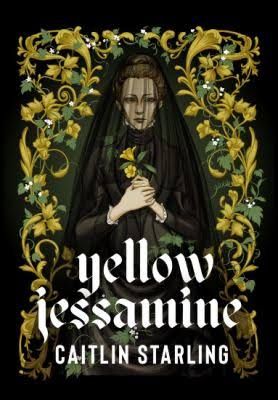
Yellow Jessamine by Caitlin Starling
I read this needing a creepy vibe to inspire my own work, and while it was absolutely creepy, I wasn’t prepared for such intensity of emotions. This story follows Evelyn Perdanu, a shipping magnate who lives in the dying city of Delphinium. Perdanu has done her damndest to keep her independence and power, at great cost. With the help of her trusted maid Violetta, Evelyn is also able to assist those in the city with her tinctures, potions, and herbal remedies. Yet something other than plague has arrived on the shores of Delphinium, something otherworldly and terrifying, and it wants Evelyn. The desolation, despair, and shock that Starling so artfully wields is beyond amazing. You want a perfect novella ending? This one blew me away.
The Future of the Speculative Novella
In addition to awards like the Nebula, Hugo, World Fantasy, my hope is that speculative novellas will become even more mainstream and easy to find in brick-and-mortar stores. Having a novella table or section at bookstores wouldn’t hurt either. I want to hear and see novellas, speculative or otherwise, on most anticipated lists and seasonal picks.
Editors, too, have hopes for this form.
“I have a few hopes for the speculative novellas future,” ring said. “I look forward to further innovations in form, voice, and structure. I look forward to folks who’ve only worked in the short form spinning out their ideas into something I can put a cover on. And I look forward to what seems like the greater number of publishers, particularly small presses and indie operations, willing to take a chance on ambitious, subversive, and challenging novella projects. Because I can’t wait to read those books.”
Chen hopes for to see more markets producing novellas and an expansion of the format within both magazines and book publishers.
“It’s such a versatile way of creating narrative, and individual editors and publishers will always have preferred styles in what they acquire, so the more variety in who’s publishing the better,” Chen said. “We need more voices writing and also more eyes buying stories. The readership is bigger than ever right now, and I’d love to see publishers meet that hunger.”
Hall sees many of these hopes already in the works.
“The future is here! Okay, I’m being silly, but also, I do feel like what I would hope for this format is already happening in a lot of ways,” Hall said. “Novellas are hitting traditional bestseller lists […] they are finding homes on shelves in physical bookstores, and they are showcasing the range of SFF in wonderful, one-sitting, immersive reads — literary, cozy, terrifying, heartbreaking, beautiful. There isn’t a limit to what kind of story can shine in this space, which is great.”
